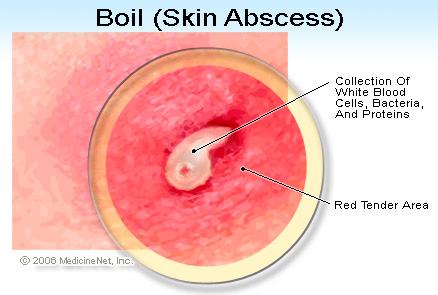April 9, 2018
Thank you to all who donated to Charity Water.
Don't miss the quality ideas section to the left. Very good post to read from Deep roots at home.
Abscess
Last week we discussed the three major players in the insect world that transmit pathogens and cause disease. The other major concern with insect bites is secondary local skin infections that occur when humans scratch open the
itchy papule and seed the area with bacteria that reside under their nails. The most common bacterial pathogens of skin infections are Streptococcus progenies and Staphylococcus aureus. Staphylococcus, staph for short, comes in two flavors, resistant/MRSA or sensitive/MSSA. For this article, we are going to discuss staph as it is the causative agent in abscess formation.
An abscess is a collection of pus under the skin that is produced when Staph or other organism grows unchecked. The area becomes warm and tender as the pus accumulates. It will continue to grow until it is surgically opened or begins to drain by popping under pressure.
Staphylococcus is not always pathogenic or disease producing as this bacteria is also a commensal organism that lives in our gut microbiome. It is a member of the firmicutes family that is associated with aging and obesity when it is found in high volume in the human gut. The source of this organism in its pathogenic form for most of us is in our nasal cavity where 1 out of 3 humans carry the MSSA bacteria but are not sick from it. 1 out of 100 humans carry the resistant strain in the nose. The main issue is that MRSA has left the hospital and is now found everywhere.
From the CDC: "Anyone can get MRSA on their body from contact with an infected wound or by sharing personal items, such as towels or razors, that have touched infected skin. MRSA infection risk can be increased when a person is in activities or places that involve crowding, skin-to-skin contact, and shared equipment or supplies. People including athletes, daycare and school students, military personnel in barracks, and those who recently received inpatient medical care are at higher risk."
In the clinic setting, we see abscesses frequently in infants that have had a diaper rash that gets seeded with MRSA or young children with insect bites that have been itchy and scratched open. The child is rarely feverish, but he or she will have a tender wound that is red and fluid filled. This issue almost always requires medical attention unless it drains itself and the immune system kills the pathogen. Staphylococcus is not to be trifled with as it can kill if it spreads into the blood stream.
"Traditionally, drainage has been the mainstay of therapy for the majority of staphylococcal abscesses; this has held true in the contemporary era of CA-MRSA in several studies. In a prospective cohort study by Lee et al. of children presenting to a large emergency department with skin and soft tissue infections, >75% of children experienced clinical cure following incision/drainage, even if prescribed an antibiotic that was ineffective (based on eventual susceptibility results)" (1)
The key to all skin infections is early recognition and effective management through drainage or antimicrobial therapy as needed.
Staph abscess pictures are found by typing Staphylococcus abscess in google images.
What to do to prevent or treat a current infection?
1) Prevent insect bites by using effective insect repellants and long sleeve clothing as needed. Use topical products with DEET or oil of lemon eucalyptus 30% to prevent mosquito and tick bites. (not for kids under 3 years old). See the EWG's website for details. It is an excellent source of information for safe chemical use. Apply all repellents by hand to avoid inhalation by your child.
2) Treat lesions with calendula or cortisone creams to prevent the itch scratch cycle. Also, rubbing a moist tea bag on bites can help with itching and swelling. The tannins act like an astringent.
3) Rub isopropyl alcohol three times a day on all lesions that have been excoriated open by scratching until healed. You can also use a diluted bleach solution of 1/8 teaspoon bleach in 16 ounces of water. Rub on topically and leave on for 15-30 minutes.
4) Keep nails cut short and filed down to remove hiding places for bacteria.
5) If you are colonized with MRSA or MSSA, treat the anterior nares with mupirocin antibiotic cream to kill of the pathogen. Taking a bath for 15 minutes in a bathtub filled with water and added bleach at a ratio of one teaspoon per gallon is effective at reducing staph colonization of the skin. Doing both daily for a week is the best plan of attack. Keep bedding and clothing washed frequently.
6) Eat a high fiber and anti inflammatory diet as this will feed the healthy gut bugs that will suppress the overgrowth of staph. This will also keep your immune system primed to fight.
No abscesses allowed,
Dr. Magryta


